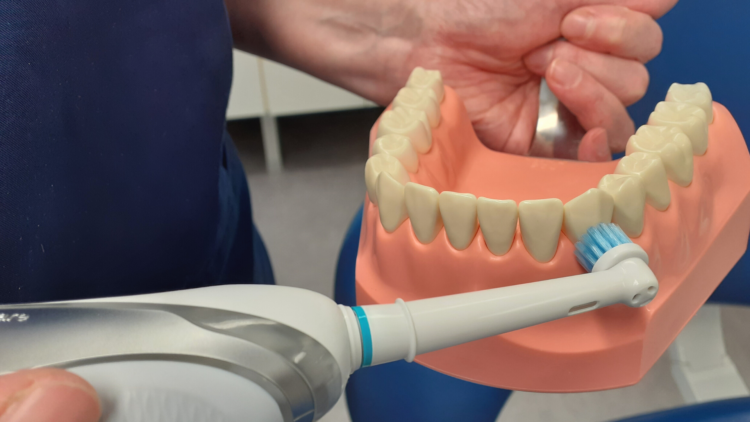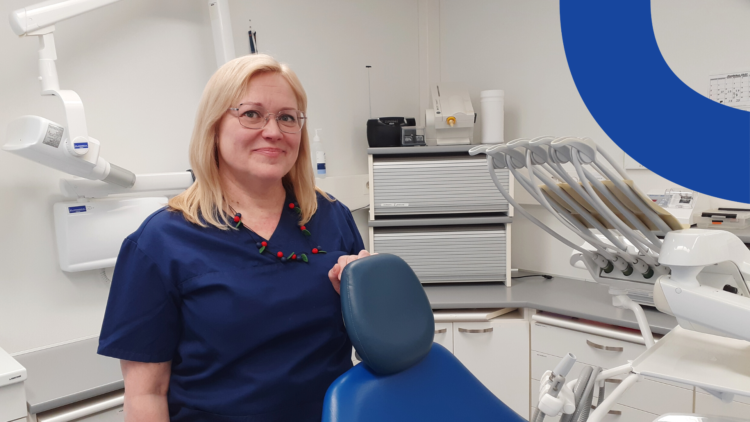Gingivitis is a common national disease

Gingivitis is a problem for both children and adults, a real national disease. Gums are sensitive, red, swollen and bleed. The symptoms start when bacterial coverings, or plaque, accumulate on the surface of the tooth.
Small and localised outbreaks of gingivitis can be cured at home, with careful and regular tooth brushing and flossing.
– You shouldn’t avoid cleaning your teeth when your gums are showing symptoms. The gums will only become more irritated if they are not cleaned, says specialist dentist Susanna Starck.
The gums bleed as part of the body’s defence reaction to irritation caused by bacteria.
Prolonged gingivitis can lead to periodontitis, i.e. tooth connective tissue disease, where the connective tissues that hold the tooth in place are destroyed around the tooth. Then the gingival pockets deepen, which create even better habitats for harmful bacteria.
– Here, too, daily cleaning is a form of treatment. A bacterial film containing a vast number of bacteria thrives in gingival pockets. The deeper the pockets, the more bacteria there is.
When you regularly clean between your teeth with dental floss or an interdental brush, you can remove the irritating bacterial mass from the gumline and oxygen can kill any bacteria that are thriving in an oxygen-free environment.

Cleaning for prevention and care
Periodontitis is a multifactorial disease which some are inherently susceptible towards having. When susceptibility is combined with certain bacteria, smoking and poor oral hygiene, the worst result can be tooth loss already in early middle age.
– The absence of symptoms makes periodontitis a common disease. Big changes in the connective tissues of the teeth take place in secret and you only notice them yourself when the bone around the tooth has disappeared, says Starck.
When gaps have appeared between the teeth, their position has changed or the tooth moves, there is already significant damage to the connective tissues.
Deepened gingival pockets are found during a dental examination. Therefore, in addition to daily self-cleaning, monitoring is important. The true condition of the teeth, gums and connective tissues can only be determined by a dentist’s examination, where, among other things, the depth of the gingival pockets is measured, the bleeding is mapped and X-rays are taken of the dentition.
Brushing your teeth twice a day and sufficiently close to the gumline, regular mealtimes and the use of xylitol products help prevent gingivitis.
Oral bacteria is the culprit
The mouth is not a separate part of the body, reminds Starck. The whole body reacts whenever there is an inflammation in the mouth.
If the gums are constantly inflamed and have deep gingival pockets, there can be up to 20 square centimetres of infected area in the mouth – that is, an inflamed area the size of an adult’s palm.
– Every time you bite, bacteria enter the general circulation. For example, for the elderly with poor general health, this can be very fatal. They ingest and also inhale bacteria, which can cause, for example, pneumonia.
Starck says that Finnish studies have found that periodontitis is connected to the occurrence of cardiovascular diseases. A possible connection with high blood pressure has also been established.
Diabetics have an increased susceptibility to infections in the oral region.
– High blood sugar increases the risk of inflammation, but treating periodontitis can alleviate low-grade inflammation in the body. In type 2 diabetics, the treatment improves blood sugar balance, says Starck.
Tell about medication
Starck wants to remind people that it is always necessary to tell the dentist about basic diseases and medication.
– Medicines can, for example, reduce saliva secretion or cause an overgrowth of the gums, which can be a nasty disease if left untreated. If you use drugs that weaken the immune defence system, antibiotics may be needed in connection with dental treatment.
Surgery is also often preceded by a visit to the dentist. For example, for artificial joint surgery, a certificate of oral health is required from a dentist in order to minimize the risks of infection spreading from the mouth to the bloodstream.
Bacteria facts from the mouths of Finns
Normal flora grows in the mouth, which is made up of a large number of different microbes, i.e. bacteria, viruses and fungi. In a healthy mouth, they prevent the growth of harmful microbes.
Caries, or tooth decay, and gingivitis are among the ten most common infections in the world. Both can be prevented with good oral hygiene.
Three out of four men over the age of 30 suffer from gingivitis.
Two thirds of people aged 35–44 have deepened gingival pockets. Deepened gingival pockets are a slightly more common problem in men than in women.
Signs of severe attachment loss start to appear clearly already in 20-40-year-olds, when there are no more invitations for regular check-ups after the end of educational studies.
